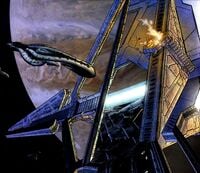Jupiter: Difference between revisions
From Halopedia, the Halo wiki
mNo edit summary |
Dragonclaws (talk | contribs) (remove realworld/high category/irrelevant category) |
||
| Line 1: | Line 1: | ||
{{Era|Forerunner|Human|UNSC|HCW | {{Era|Forerunner|Human|UNSC|HCW}} | ||
{{ratings}} | {{ratings}} | ||
{{Planet | {{Planet | ||
|name=Jupiter | |name=Jupiter | ||
| Line 58: | Line 57: | ||
<references/> | <references/> | ||
[[Category:Planets]] | [[Category:Planets]] | ||
Revision as of 03:44, September 12, 2010
Template:Ratings Template:Planet
Jupiter is the largest planet in the Solar System. It was the site of various battles, dating back from the Interplanetary War to the Human-Covenant War.
History
Jupiter has been known since ancient times, however its four Major moons, also known as Galilean moons, were only discovered in 1610 by Galileo. In 1892, a fifth moon of Jupiter was discovered, but smaller than the four others. Humans first sent spacecraft was in late 1973, known as the Pioneer 10. Other spacecrafts soon followed, thus discovering more moons and increasing the understanding of the gas giant. Jupiter has rings that are much fainter than those of Saturn's, which were discovered years later after the visit of the first spacecraft.
Interplanetary War
Jupiter represented a major battle zone during the Interplanetary War.
Jovian Moons Campaign
- Main article: Jovian Moons Campaign
During the Jovian Moons Campaign of 2160, the Frieden secessionist movement attacked the UN Colonial Advisors stationed on Io. The attack led to the Jovian Moons Campaign and the beginning of the Interplanetary War.[1]

Human-Covenant War
During the Human-Covenant War, Jupiter was once again a location of particular importance.[2] Io Station detected a Covenant Fleet of 15 ships exiting Slipspace just outside of Jovian space a few moments before the Battle of Earth.
The Forerunner Dreadnought and Truth's Fleet escorting it passed Jupiter while on their way to Earth.[3]
Characteristics
Average Orbital Speed: 13.07 km/s
Volume: 1.43128×1015 km³
Surface Area: 6.21796×1010 km²
Equatorial Rotation Velocity: 45,300 km/h
Surface Pressure: 20–200 kPa